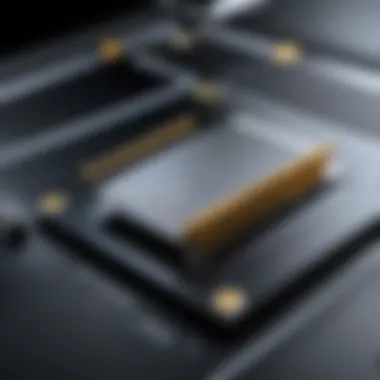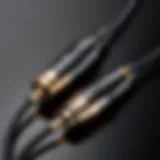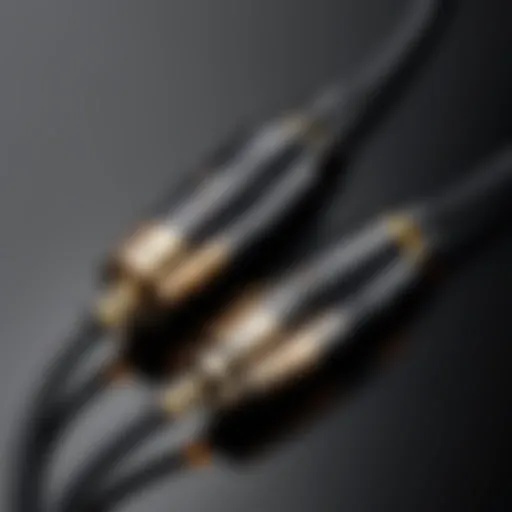Furrion Antenna Replacement: A Detailed Guide


Intro
When it comes to enhancing your signal reception, particularly in the realm of mobile and recreational vehicles, the Furrion antenna stands as a prominent choice. However, as with any electronic device, there comes a time when replacement becomes necessary. This guide is designed to help readers navigate the sometimes murky waters of replacing their Furrion antennas. We’ll delve into various significant aspects that are key to making an informed decision, including compatibility, installation, and maintenance.
Understanding the mechanics behind these antennas is vital, especially with an increasing number of options available in the market. This is not just about swapping out one device for another; it's about selecting the right one for your specific needs, ensuring easy installation, and long-term maintenance to maximize performance. In the sections that follow, we’ll cover everything from the product overview, including what sets Furrion apart, to a breakdown of specifications that matter, and comparative analysis against rival products.
Readers—whether tech enthusiasts, DIY builders, or casual users—will find insights and tips that cater to their unique perspectives and needs. Let's dive into the details.
Understanding Furrion Antennas
Furrion antennas are engineered with precision to meet the growing demands of modern communication. Understanding these antennas is critical for anyone looking to optimize signal reception, whether for leisure, leisure, or any myriad of purposes. The clarity of your television or internet connection largely hinges on the type of antenna you employ, making it paramount to delve into the essentials of Furrion.
The Role of Antennas in Modern Technology
Antennas are the unsung heroes of wireless communication. They capture electromagnetic waves and convert them into signals that devices can utilize. In the age where streaming and data transfer is becoming the norm, having a reliable antenna ensures that you won't miss a beat. With everything riding on seamless connectivity, the importance of investing in the right antenna cannot be overstated. Just as you'd be lost without a map, your devices would struggle to find their signals without a good antenna.
Types of Furrion Antennas Available
Furrion offers a variety of antenna types, catering to different needs and preferences. It's essential to understand these options to make informed replacement choices.
Digital TV Antennas
Digital TV antennas are crucial for receiving high-definition signals from broadcast stations. These antennas stand out due to their ability to filter out unwanted noise, ensuring that the clarity of your favorite shows remains intact. They’re particularly popular among those who want to cut costs on cable subscriptions. A distinct advantage lies in their plug-and-play functionality, making them user-friendly. However, the range may sometimes fall short in rural areas, forcing users to consider alternative solutions if distance from broadcast stations is significant.
Satellite Antennas
Satellite antennas are designed for enthusiasts seeking broader coverage without limitations imposed by terrestrial broadcasting. They receive signals from satellites stationed above the earth, allowing for global access to programming. This type is widely recognized for its key characteristic of offering diverse content, often unavailable through standard cable channels. Yet, it comes with its own unique elements, such as a reliance on clear skies for optimal performance. Rain can interrupt signals, making it a less favorable option during inclement weather.
Signal Amplifiers
Signal amplifiers play a pivotal role in enhancing the reception capabilities of other types of antennas. They boost weak signals, making them clearer and more robust. This can be especially beneficial in areas where signal quality tends to waver. They are a popular choice for users experiencing dead zones or weak reception. Importantly, they can be added after the initial installation without the need for complete system overhauls. However, they may potentially amplify background noise, which is a disadvantage worth recognizing.
In summary, understanding the various types of Furrion antennas not only aids in making the best replacement choices but also enhances the overall connectivity experience. That’s a win-win for anyone venturing into the world of modern communications.
When to Replace Your Furrion Antenna
Understanding when to replace your Furrion antenna can save you from endless frustation and help you enjoy clearer connections. Many tech enthusiasts take their antennas for granted, thinking they can be left alone indefinitely. This can be a big mistake as an ineffective antenna can lead to poor reception, leading to a subpar experience when streaming your favorite shows or gaming online. Identifying the right moment for replacement ensures that you maintain the optimal performance of your entertainment systems.
Signs of Antenna Signal Failure
There are a few telltale signs that indicate your Furrion antenna may be on its last legs. Look out for the following:
- Consistent patchy signals: If you find yourself losing signals frequently, especially in areas that were previously stable, this could be a clear indication that the antenna isn't functioning properly anymore.
- Muffled sound or pixelated images: If your television experience is plagued by choppy visuals, annoying audio interruptions, or fuzzy screens, that might point to antenna issues rather than signal source problems.
- Increased interference: Substantial noise or interference during broadcasts often highlights a weakened antenna. Compare how reception was before; if only one channel is facing trouble, the source itself may be to blame.
"A failing antenna might not throw a red flag, but its subtle signs can disrupt your entertainment life significantly"
Declining Performance Over Time
Just like any technological equipment, Furrion antennas aren’t immortal. Over time, components can wear out due to exposure to natural elements, heat, and humidity. Here are key indicators to recognize:
- Age: If your antenna is several years old, you might want to consider a replacement as even high-quality devices tend to decline, especially if they're exposed to various weather conditions.
- Expectations vs. Reality: Have you noticed that the quality of broadcasts no longer meets your standards? If you were once satisfied with your antenna's performance and are now constantly tweaking it, replacement could be the answer.
- Outdated Technology: Changes in broadcasting technology over the years can also hurt the performance of older antennas.
Physical Damage Assessment


Physical inspections can yield pretty vital clues about the state of your antenna. Here's what to check for:
- Corrosion or Rust: Outdoor antennas especially tend to suffer from rust due to weather exposure. If you spot rust, further breakdown is likely just around the corner.
- Bend or Breaks: A bent arm or damaged elements can severely affect reception. Take a good look; sometimes the damage can be subtle yet impactful.
- Loose Connections: Regularly check all connections. If you notice any cords that don’t feel right, maybe it’s time to reassess whether it's just the cable or if the whole antenna needs replacing.
In summary, keeping an eye on these signs and factors will not only ease troubleshooting when issues arise, but also extend your enjoyment of your entertainment system by ensuring your Furrion antenna works effectively. Recognizing when to make the call is power; don’t let a declining antenna rob you of fun.
Selecting a Compatible Replacement Antenna
When it comes to replacing your Furrion antenna, getting the right fit is not just important, it’s essential. With a variety of options available on the market, understanding how to select a compatible replacement ensures you don’t run into issues down the line. Picking the wrong antenna can hamper your signal quality and your overall viewing experience. Thus, careful selection considers specifications, brand compatibility, and the cost-effectiveness of the options at hand.
Comparing Specifications
Diving into specifications is like reading the fine print before signing a contract; it lays the groundwork for a successful experience. The specs provide crucial insights, such as frequency range, gain ratings, and coverage area. For instance, if your area primarily operates on VHF frequencies, then opting for an antenna that supports UHF may lead to weak signal reception.
When comparing different antennas, here are some specs to delve into:
- Gain: Higher gain usually means the antenna can capture signals more effectively, but also consider the trade-off between sensitivity and directivity.
- Frequency Range: Confirm that the antenna works well with the channels you commonly watch.
- Installation Requirements: Look for antennas that fit your installation capabilities—do you need to climb a roof?
"Antenna gain is like a magnifying glass; the better the quality, the clearer the picture you’ll see."
Each detail matters. If you skip over this, you might find yourself stuck with a device less effective than you hoped.
Brand Compatibility Considerations
Brand matters too—catering to specific models and configurations can prevent compatibility troubles. While Furrion antennas are designed with certain features, switching to another brand could create issues if the mounting system or connectors differ.
You should also consider accessories: maybe you have a Furrion pre-installed cable system. This means your new antenna needs to connect seamlessly with what’s already there. Here's why brand compatibility should be on your checklist:
- Connector Types: Ensure your new antenna has compatible connectors for easy installation. Furrion typically uses specific types that may not match all brands.
- Mounting Compatibility: Mounts must align with your current setup, otherwise, you’ll face additional hassle just to fit it.
- Warranty and Support: Some brands offer lifetime warranties, while others may not support third-party devices.
All these factors play a significant role; they ensure you won't be left in the lurch with an incompatible antenna.
Cost-Effectiveness Analysis
Lastly, let’s talk dollars and cents. Cost-effectiveness isn’t just about finding the cheapest option; it’s about striking a balance between price, quality, and longevity. Sometimes, shelling out a bit more up front saves you extra headaches down the line.
To evaluate this effectively, consider:
- Initial Cost vs. Quality: A low-cost alternative may not perform well or last long enough, leading you to replace it sooner rather than later.
- Buying Used vs. New: Sometimes second-hand antennas can do the trick. Just ensure they’re still in good shape.
- Maintenance Expenses: Some antennas may require more upkeep than others, and that should factor into your overall cost analysis.
It’s wise to weigh all these elements carefully—what looks good on paper might not be what you need once installed.
Choosing an antenna replacement wisely is about understanding your requirements and knowing the market. With so many options available, making informed choices tailored to your needs is not just a benefit but absolutely vital.
Installation Process for Furrion Antennas
Getting into the nitty-gritty of installing a Furrion antenna is where the rubber meets the road. This section is all about ensuring that your replacement process goes off without a hitch. A well-executed installation can mean the difference between crystal-clear reception and a frustrating jumble of pixels or complete signal loss.
When you're replacing your antenna, the installation steps you take can heavily influence not only how well your new antenna performs but also its longevity and durability. Each phase of this process, from gathering the right tools to connecting everything correctly, lays the groundwork for your antenna to operate effectively.
Whether you’re a seasoned DIY enthusiast or a tech novice, having a clear guide can make this task feel a bit like riding a bike—once you know, you won’t forget. Now let’s roll up our sleeves and dive into this.
Tools Required for Installation
Before you embark on your adventure of removing the old antenna and fitting the new one, let's gather our toolkit. You’ll need the following:


- Screwdriver Set: A common Phillips and flathead will work wonders.
- Wrench or Pliers: For tightening or loosening any stubborn bolts.
- Cable Strippers: You may need these if you need to adjust cable lengths.
- Level: Ensuring the antenna is straight could save you a headache later.
- Drill: Essential if new mounting holes are necessary.
- Safety Gear: Like gloves and goggles, just to keep things safe.
Having the right tools ready not only speeds up the installation but also helps prevent mishaps, making this part of the process a bit easier than trying to juggle tasks.
Step-by-Step Installation Guide
Getting down to the brass tacks, it's time to follow this step-by-step guide. Every part of this installation process is crucial and any missed step could mean having to backtrack later.
Removing the Old Antenna
Before you can make way for your shiny new Furrion antenna, you've got to say goodbye to the old one. This part is about dismantling, so precision is key here. Begin by locating the mounting screws—these usually sit atop the antenna. Once you get those off, gently disconnect any cables still attached to it. Being tender-footed here is crucial; you don’t want to damage any wiring still in use.
The main perk of removing the old antenna properly is you reduce the risk of damaging your roof or other components of your installation. It’s really worth taking the time to do it right. If the antenna is stuck, don’t force it; sometimes a bit of lubricant can aid in dislodging it.
Mounting the New Antenna
Now, let’s focus on the fun stuff—putting in the new antenna! Once you’ve got the old one out of the way, place the new antenna in the same location to avoid drilling any new holes unless necessary. Start by firmly securing it to the mount, ensuring everything is snug but not overly tight, as this can cause damage.
A unique characteristic of Furrion antennas is their design focus on aerodynamics which minimizes wind damage. By securely mounting the antenna, you really set it up for longevity in various weather conditions. Just be cautious not to cross-thread bolts; that could lead to a right mess down the line.
Connecting Cables and Power Source
Lastly, connecting the cables and ensuring the power source is hooked up properly is non-negotiable. This bit’s a little like putting the icing on the cake. Make sure to match the cables to the appropriate ports on the new antenna. Typically, coax cables are involved, which require a gentle twist-on connection. If power is involved, refer to the installation manual for clarity on connections.
The standout feature of this process is the solidified connection that guarantees good signal strength. If you skip this step, the performance could take a nosedive—or worse, nothing at all. Check each connection before moving on to the next phase; a minute spent now could save you hours of troubleshooting later.
Testing Signal Strength Post-Installation
After all that hard work, you certainly don’t want to jump the gun without checking if everything’s up to snuff. Grab your TV remote and run through a full channel scan. You want to observe consistency in signal strength across channels. If you encounter issues here, relearning the installation steps might be necessary, but all your effort in making the correct connections will yield positive outcomes if done right.
Maintaining Your Furrion Antenna
Maintaining your Furrion antenna is not just about keeping it clean; it’s an essential part of ensuring that you receive the best signal possible. Proper maintenance prolongs the lifespan of your antenna while also guaranteeing its efficiency. Over time, exposure to the elements can lead to wear and tear, making regular checks and upkeep critical. If you neglect this aspect, you could find yourself dealing with fluctuating signal quality, which can be frustrating if you rely on clear, stable reception.
In this section, we'll delve into two main areas: routine maintenance practices that keep your antenna in top shape and troubleshooting common issues that may arise.
Routine Maintenance Practices
Routine maintenance involves a few straightforward practices that can have a significant impact on your Furrion antenna’s performance. Some of these tasks include:
- Regular Cleaning: Dust and debris can accumulate on the antenna. Wiping it down a few times a year helps keep it free from materials that might obstruct signals.
- Checking Connections: Ensure that all cables and connectors are securely attached. Loose connections can lead to signal loss.
- Inspections for Damage: Periodically inspect the antenna structure for signs of wear, rust, or any physical damage. This quick check can help you catch issues early before they become costly problems.
By adopting these practices, you can save yourself from unexpected issues and ensure that your Furrion antenna functions effectively throughout its life.
Troubleshooting Common Issues
Sometimes, despite best maintenance efforts, antennas may still experience problems. Below are common issues and their troubleshooting methods:
Signal Fluctuations
Signal fluctuations are among the most common issues faced by antenna users. They often stem from various sources, including obstructions like trees, buildings, or even other electronic devices emitting interference. The main characteristic of signal fluctuations is their unpredictability, which can lead to interruptions during crucial moments, such as sports games or movie nights.
In this article, we emphasize addressing this issue diligently. For instance, identifying and removing nearby sources of interference can significantly improve your reception. Testing your antenna in different positions as well as considering a signal booster can be beneficial strategies to stabilize the situation.
Physical Inspections


Conducting physical inspections of your Furrion antenna is an integral part of maintaining its overall effectiveness. Inspecting the antenna regularly allows you to discover potential issues like cracks, rust, or loose fittings that could hinder performance. This practice is widely regarded as a beneficial approach for tech-savvy users who wish to maximize the longevity and efficiency of their devices.
Look closely at channel screws, mounts, and bolts during these inspections, ensuring everything is intact. If you notice any problems, addressing them immediately can prevent further complications later.
Adjustments to Angle and Position
Adjustments to the angle and position of your Furrion antenna can play a crucial role in signal quality. The inherent flexibility of these antennas allows users to experiment with different angles to minimize signal loss. A strong signal typically comes from broadcasting towers that are as clear as possible in view, so the positioning might need adjustments depending on your location.
It's worth noting that the correct angle can sometimes vary with seasons, as foliage can obstruct signals in warmer months yet allow for better reception in winter. Being proactive and adjusting the antenna periodically can offer a simple yet effective solution to maintaining optimal performance.
Regularly inspecting and adjusting your Furrion antenna can prevent costly repairs and enhance your viewing experience.
Exploring Alternatives to Furrion Antennas
When it comes to enhancing your signal reception, looking beyond Furrion antennas can be a wise move. This section delves into significant alternatives, offering insights into other brands and DIY solutions that can potentially match or even surpass what Furrion provides. Exploring alternatives isn't just about seeking different brands; it's about discovering products that might be better suited to individual needs, preferences, or specific setups.
The reason to consider alternatives primarily revolves around the quest for optimal performance and compatibility with existing systems. As technology evolves, new antenna models emerge, often packed with advanced features that could seamlessly integrate into your setup. For instance, while Furrion has made a name for itself, options such as Winegard, King, or even custom antennas built by tech enthusiasts can offer enhanced capabilities, perhaps at a better price point or with an added twist in technology.
Other Antenna Brands Worth Considering
If you’re weighing your options, other brands definitely deserve your attention.
Here are a few noteworthy mention:
- Winegard: Known for their long-range capabilities, Winegard antennas have gained a reputation for reliability, especially in rural areas where reception can be tricky. Their units often come with good build quality and support.
- King: This brand specializes in portable and fixed antennas. Their products tend to be compact yet effective, making them suitable for both simple and complex setups.
- Mohu: If you're interested in more minimalistic and aesthetic designs, Mohu’s line of paper-thin antennas might appeal. They cater mainly to cord-cutters seeking clean design without compromising on performance.
- Channel Master: With a robust range of antennas that are well-reviewed for digital reception, Channel Master products often feature advanced technologies that provide clarity and reliability.
Making an informed choice between these brands requires considering factors like the terrain, distance from broadcast towers, and specific use cases, be it for your RV, home, or while on the go.
DIY Antenna Solutions
For those with a penchant for tinkering, crafting your own antenna can be both a satisfying and cost-effective solution. Reading the articles and forums on sites like Reddit or Instructables can provide a trove of information about DIY antennas that don’t require extensive technical knowledge.
Here are easy ideas to jumpstart your DIY journey:
- Coaxial Cable Antenna: Utilizing coaxial cable, you can create an efficient dipole antenna that’s straightforward to construct. There are plenty of tutorials that guide you through measurements and assembly.
- Wire Antennas: Simple wire antennas can be made using household materials, such as copper wire. These antennas can be custom-sized based on your specific needs.
- Cardboard Antennas: Utilizing cardboard frames to hold wires can be an innovative way to create a lightweight antenna that can be adjusted easily for optimal reception.
Feel free to experiment, as creating a DIY antenna allows for custom sizing and adjustments according to your needs and preferences.
Always ensure to double-check local regulations regarding signal reception devices, as some modifications might not be permissible in certain areas.
In summary, venturing beyond Furrion antennas opens a landscape of possibilities. Other brands can offer unique advantages, and DIY projects not only provide personal satisfaction but also an opportunity to understand signal technology up close. Each option provides various advantages, ensuring that you can find what works best for your specific situation.
Final Thoughts on Furrion Antenna Replacement
Replacing a Furrion antenna is not just a matter of swapping out old for new. It’s about ensuring connectivity, two-way communication, and an overall enhanced experience that aligns with the tech-savvy nature of today's society. Understanding the nuances within this process allows individuals to harvest the long-term benefits of a well-functioning antenna system.
Assessing Long-Term Value
When considering the replacement of a Furrion antenna, evaluating its long-term value is paramount. This value isn't quantified merely in terms of cost but encompasses several critical elements:
- Performance Sustainability: A good antenna should not only serve its purpose effectively in the short run but continue to provide quality service over years. Regular maintenance and periodic upgrades can keep the signal strong.
- Future-Proofing Your Setup: Technology evolves at lightning speed. The Furrion antenna you choose should be compatible with emerging technologies, ensuring you won't need to repeat this process prematurely. Look for models that support future broadcasting standards.
- Cost Efficiency: An upfront investment may seem high, but when spread over years of reliable service, it often proves to be economical. Scrutinizing the warranty periods and repair costs of various models contributes greatly to understanding their long-term financial implications.
Understanding these aspects can arm you to make choices that truly fit your digital lifestyle, preventing frequent replacements that dig deep into your pocket over time.
Integration with Other Technologies
Modern antennas, like those from Furrion, don’t operate in isolation; they are part of a greater ecosystem of connected devices. The integration with other technologies creates a seamless user experience:
- Smart Home Compatibility: Many Furrion antennas can work in conjunction with smart home systems. For instance, linking antenna functionality with devices like Amazon Alexa for voice control or incorporating smart TVs enhances user interaction.
- Mobile Devices and Streaming: With the rise of streaming services, using antennas that can support mobile devices adds to usability. This combination is where true convenience lies—watching favorite shows with impeccable clarity, regardless of the platform.
- Wi-Fi and Internet of Things (IoT): The ability to mesh an antenna with existing Wi-Fi networks or even IoT appliances can increase accessibility and functionality. For example, antennas that bolster home internet connectivity can lead to smoother streaming and enhanced gameplay.
In a world where technology interconnects, ensuring your Furrion antenna integrates well with other devices is crucial for a streamlined experience.
By understanding the value of longevity and integration, you can ensure that your replacement antenna is not just a temporary fix, but a stepping stone to a more connected and efficient tech life. Opt for choices that resonate not only today but also tomorrow.



